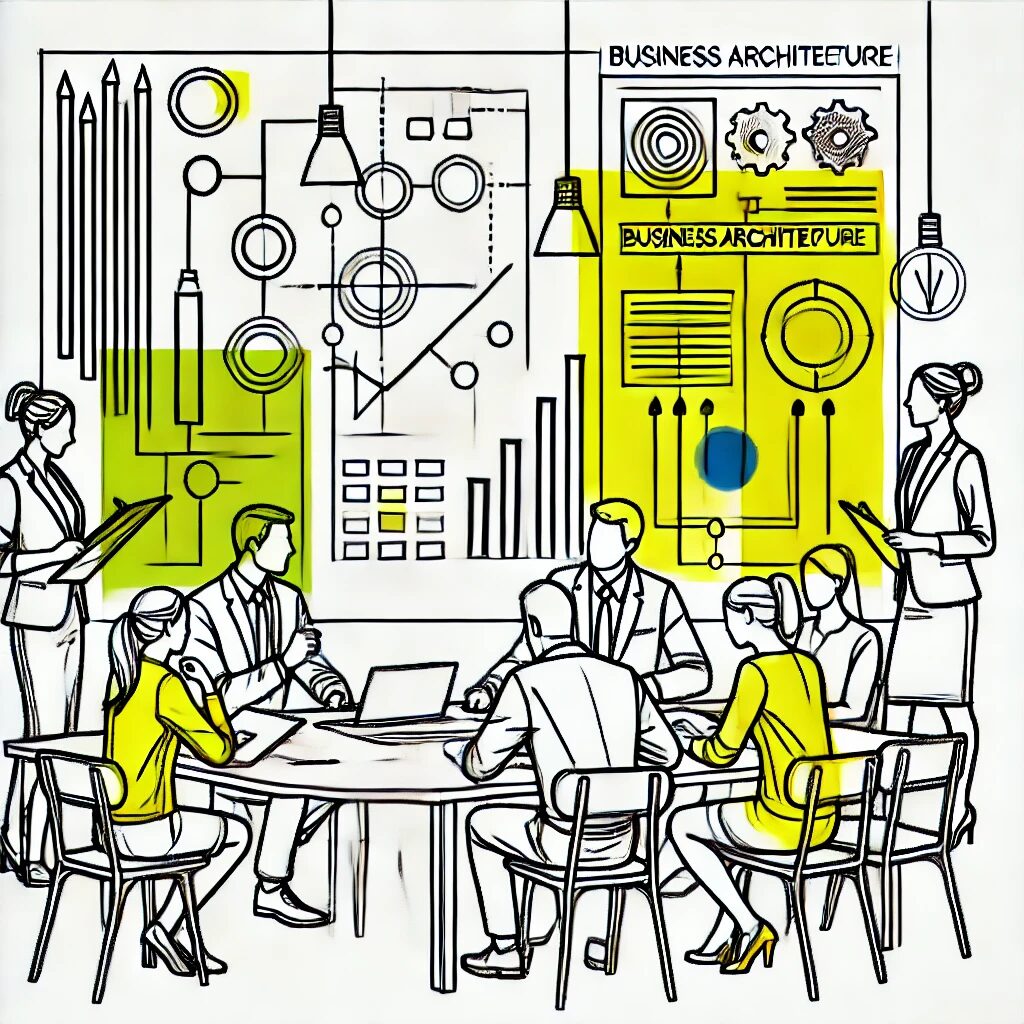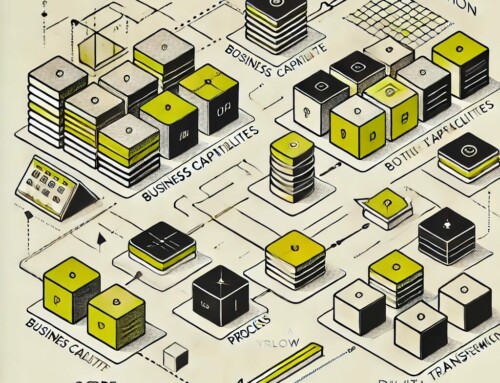
Business Architecture as the Recipe for F&B Transformation. Blend strategy with execution to create a future-ready food and beverage enterprise.
In today’s rapidly evolving food and beverage landscape, manufacturers face unprecedented challenges – from shifting consumer preferences and sustainability demands to supply chain disruptions and regulatory pressures. Traditional approaches to business transformation often fall short, creating disconnected initiatives that fail to deliver cohesive results.
Business Architecture offers a systematic framework that connects strategic intent with operational reality, providing food and beverage manufacturers with the blueprint needed to navigate complexity, drive innovation, and create resilient, responsive organizations. By mapping capabilities to outcomes, abstract strategies are transformed into actionable roadmaps for sustainable growth.
1: The Transformational Imperative for F&B Manufacturers
Food and beverage manufacturers operate in an environment of constant change, where market dynamics, consumer expectations, and regulatory requirements continuously evolve. Transformation is no longer optional but essential for survival and growth.
- Accelerating Change: The food and beverage industry is experiencing its most significant disruption in decades, with consumer preferences shifting at unprecedented speeds.
- Competitive Pressure: New market entrants with agile business models are capturing market share through innovation and responsiveness.
- Sustainability Mandates: Environmental considerations have moved from optional to essential, with expectations for reduced carbon footprints, ethical sourcing, and minimal waste.
- Supply Chain Vulnerability: Recent global disruptions have exposed the fragility of traditional supply chains, necessitating more resilient networks.
- Digital Acceleration: Technologies from IoT to AI are transforming every aspect of the industry, from production to consumer engagement.
2: Business Architecture as the Foundation for Transformation
Business Architecture provides the essential framework that connects strategic intent to operational execution, creating alignment across the enterprise. It serves as the blueprint for organizational design and transformation.
- Strategic Alignment: Business Architecture establishes clear traceability from corporate vision to operational processes, ensuring all transformation initiatives advance strategic goals.
- Capability Focus: By centering on business capabilities rather than organizational structures, Business Architecture creates a stable reference point for transformation regardless of organizational changes.
- Complexity Management: The multilayered frameworks of Business Architecture help decompose complex challenges into manageable components without losing sight of their interrelationships.
- Change Acceleration: A well-defined architectural approach reduces transformation cycle times by providing pre-established patterns and models adapted to industry needs.
- Investment Optimization: Business Architecture enables more effective resource allocation by identifying capability gaps, redundancies, and opportunities for consolidation.
DID YOU KNOW?
- According to McKinsey, food and beverage companies with mature Business Architecture capabilities achieve 2.5x higher success rates in transformation initiatives than those with ad hoc approaches.
3: The Business Architecture Value Proposition for F&B
Business Architecture delivers specific, measurable value to food and beverage manufacturers navigating transformation. Its structured approach addresses the unique challenges facing the industry.
- Value Chain Integration: Business Architecture creates cohesive end-to-end views that span from ingredient sourcing to consumer experience, breaking down organizational silos.
- Regulatory Adaptability: The capability-based approach makes integrating new regulatory requirements more systematic and less disruptive to ongoing operations.
- Innovation Enablement: By mapping innovation capabilities and their dependencies, Business Architecture creates a foundation for sustainable product and process innovation.
- Technology Alignment: Business Architecture bridges the gap between business needs and technology implementations, ensuring IT investments directly support business outcomes.
- Transformation Governance: The architectural framework provides clear metrics and milestones for measuring transformation progress against strategic objectives.
4: Core Elements of F&B Business Architecture
A comprehensive Business Architecture for food and beverage manufacturers consists of several interconnected components that collectively define the enterprise.
- Capability Maps: These hierarchical models define what the organization does (or should do), independent of how it’s done or who does it.
- Value Streams: End-to-end process visualizations show how capabilities combine to deliver value to customers and stakeholders.
- Information Models: These structures define critical business concepts and their relationships, ensuring consistent understanding across the enterprise.
- Organizational Models: These mappings show how resources, roles, and responsibilities align to capabilities and processes.
- Strategy Models: These frameworks connect business motivations to objectives, strategies, and tactics, creating a cohesive direction.
5: Mapping the F&B Capability Landscape
Capability mapping is foundational to Business Architecture, providing a stable platform for transformation planning that transcends organizational boundaries and technology changes.
- Strategic Capabilities: These differentiate the business in the marketplace, such as flavor development or sustainable packaging innovation.
- Core Capabilities: These essential functions define the business, including recipe management, production scaling, and quality assurance.
- Supporting Capabilities: These enable the organization to operate effectively, including supplier management and regulatory compliance.
- Maturity Assessment: Evaluating capability maturity provides a baseline for improvement, highlighting gaps between current and desired states.
- Heat Mapping: Visualizing capability performance against strategic importance identifies priorities for transformation investment.
6: Value Stream Orchestration for F&B Transformation
Value streams visualize how capabilities work together to deliver value, providing a process-oriented view that complements the functional view of capability maps.
- Product Development Streams: These map the journey from concept to commercialization, ensuring faster, more successful innovation cycles.
- Supply Chain Streams: These connect sourcing, production, and distribution activities, creating visibility across the end-to-end process.
- Customer Experience Streams: These track customer interactions from awareness to loyalty, identifying moments of truth for differentiation.
- Compliance Streams: These capture regulatory processes from monitoring to implementation, reducing compliance risk.
- Stage-Gate Analysis: Examining decision points within value streams identifies bottlenecks and acceleration opportunities.
7: Information Architecture for Food & Beverage
Information architecture defines the data assets essential to F&B operations, creating a foundation for analytics, AI, and process automation initiatives.
- Master Data Governance: Establishing authoritative sources for product, customer, and supplier data enables consistent decision-making across the enterprise.
- Recipe Information Models: Standardizing product specifications, ingredients, and nutritional data creates a single source of truth for manufacturing.
- Traceability Frameworks: Mapping information flows for batch and lot tracing supports food safety and recall management.
- Sustainability Metrics: Defining measurement frameworks for environmental impact supports credible ESG reporting.
- Consumer Insight Models: Structuring market research and consumer feedback data enables more responsive product development.
8: Technology Architecture Alignment
Business Architecture creates the blueprint that guides technology investments, ensuring IT initiatives directly support business capabilities and transformation goals.
- Capability-Technology Mapping: This alignment ensures each business capability has appropriate systems support without gaps or redundancies.
- Legacy Modernization: Business Architecture provides the context for determining which legacy systems to retire, retain, or replace based on business value.
- Integration Priorities: By understanding information flows between capabilities, architects can prioritize system integration initiatives.
- Digital Investment Framework: Business Architecture creates criteria for evaluating emerging technologies based on capability enhancement potential.
- Tech Debt Management: The architectural view helps identify and prioritize technical debt that impedes business agility.
DID YOU KNOW?
- Leading F&B manufacturers are now dedicating 15-20% of their transformation budgets to architectural work, up from just 5-7% a decade ago, recognizing its multiplier effect on implementation success.
9: People and Organization Architecture
Organizational design must evolve to support new capabilities, with Business Architecture providing the framework for workforce transformation.
- Skills Gap Analysis: Mapping required skills to business capabilities identifies training needs and recruitment priorities.
- Organizational Alignment: Business Architecture guides restructuring to ensure organizational units directly support critical capabilities.
- Role Definition: Clear capability ownership strengthens accountability and decision rights across the enterprise.
- Change Readiness: Architectural approaches help assess organizational readiness for transformation and design appropriate change management.
- Collaboration Models: Business Architecture identifies where cross-functional collaboration is essential for capability delivery.
10: Practical Application in Product Innovation
Product innovation illustrates how Business Architecture drives tangible business outcomes in the food and beverage industry.
- Innovation Capability Network: Business Architecture maps the interconnected capabilities needed for effective innovation, from trend monitoring to commercialization.
- Stage-Gate Optimization: Architectural analysis identifies unnecessary handoffs and approvals that slow the innovation process.
- Technology Enablement: Business Architecture guides implementation of product lifecycle management systems that support the innovation capability.
- Organizational Alignment: Clear capability ownership ensures the right resources are assigned to critical innovation activities.
- Measurement Framework: Business Architecture establishes KPIs that track innovation performance against strategic objectives.
11: Transformation Roadmapping for F&B Manufacturers
Business Architecture translates strategic intent into executable transformation roadmaps that sequence initiatives for maximum business impact.
- Capability Prioritization: Not all capabilities can be transformed simultaneously, requiring clear criteria for implementation sequencing.
- Initiative Portfolio: Business Architecture helps group related capability enhancements into cohesive transformation initiatives.
- Dependency Management: Understanding capability interdependencies prevents transformation bottlenecks and resource conflicts.
- Benefit Realization: Architectural approaches link transformation activities to specific business outcomes and value metrics.
- Risk Mitigation: Business Architecture identifies transformation risks and designs appropriate contingency measures.
12: Governance Frameworks for Sustainable Transformation
Transformation governance ensures that architectural integrity is maintained throughout implementation, preventing drift from strategic intent.
- Decision Rights: Business Architecture establishes clear accountability for architectural decisions at strategic, tactical, and operational levels.
- Standards and Policies: Architectural governance defines standards that guide implementation while allowing appropriate flexibility.
- Compliance Mechanisms: Regular architectural reviews ensure transformation initiatives remain aligned with the target architecture.
- Performance Metrics: Business Architecture defines success measures that track progress against both transformation and business objectives.
- Continuous Improvement: Governance processes capture lessons learned to refine architectural approaches over time.
13: Business Architecture in Action: Case Examples
Real-world examples demonstrate how leading food and beverage companies have leveraged Business Architecture to drive successful transformation.
- Global Beverage Leader: Used Business Architecture to restructure its innovation capabilities, reducing time-to-market by 40% for new product introductions.
- Regional Food Processor: Applied architectural approaches to redesign its supply chain capabilities, improving resilience while reducing inventory costs by 15%.
- Specialty Ingredients Manufacturer: Leveraged Business Architecture to guide its digital transformation, creating an integrated production environment that increased yield by 8%.
- National Bakery Network: Employed capability-based planning to standardize production processes across acquired facilities, achieving cost synergies 30% faster than historical integrations.
- Organic Foods Startup: Utilized Business Architecture to scale operations without losing agility, successfully transitioning from regional to national distribution.
14: Getting Started: The Business Architecture Journey
Implementing Business Architecture is itself a transformation journey that requires a thoughtful, incremental approach tailored to organizational readiness.
- Architectural Vision: Begin with a clear definition of how Business Architecture will support specific transformation objectives.
- Capability Foundation: Start with capability mapping to create a common language for transformation across the enterprise.
- Strategic Alignment: Focus initial architectural efforts on capabilities most critical to strategic differentiation.
- Quick Wins: Identify opportunities where architectural insights can deliver rapid business value to build momentum.
- Capability Building: Develop internal Business Architecture skills through training, mentoring, and communities of practice.
15: The Future of F&B Business Architecture
Business Architecture continues to evolve, with emerging trends reshaping how food and beverage manufacturers approach enterprise design and transformation.
- Ecosystem Architecture: Expanding beyond enterprise boundaries to map capabilities across partner networks and industry ecosystems.
- AI-Enabled Architecture: Leveraging artificial intelligence to maintain architectural models and generate transformation insights.
- Adaptive Architecture: Creating more dynamic architectural approaches that respond to changing market conditions in near real-time.
- Sustainability Integration: Embedding environmental and social considerations directly into architectural frameworks and decision processes.
- Experience-Driven Design: Centering architectural approaches on customer and employee experience to drive differentiation.
DID YOU KNOW?
- A 2023 industry survey found that 72% of food and beverage executives cite “lack of enterprise-wide capability visibility” as a primary barrier to transformation, a gap that Business Architecture directly addresses.
Takeaway
Business Architecture provides food and beverage manufacturers with the blueprint for successful enterprise transformation, connecting strategic intent to operational execution. Mapping capabilities, value streams, information flows, and organizational models create alignment across the enterprise and accelerate change. In an industry facing unprecedented disruption, Business Architecture is not just a methodology but a critical competitive advantage, enabling manufacturers to adapt faster, innovate smarter, and build more resilient organizations ready for an uncertain future.
Next Steps
- Conduct a capability assessment to identify gaps between your current state and future strategic needs.
- Map one critical value stream end-to-end to identify immediate improvement opportunities.
- Establish a cross-functional Business Architecture team with representation from both business and technology domains.
- Select one strategic transformation initiative to apply architectural methods as a proof of concept.
- Develop capability heat maps that highlight the most critical areas for transformation investment.
- Create a Business Architecture communication plan to build understanding and buy-in across the enterprise.



